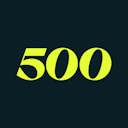2017.05.25

Guest Author

Guest Blogger – Brittany Murlas, Mentor, 500 Startups
Optimizing adds on Pinterest isn’t necessarily straightforward, and can often involve a lot of trial and error. Brittany Murlas, a mentor for 500 Startups, spent time and money navigating what works and what doesn’t on the platform and imparts her hard-earned lessons below. Read on so you avoid the same mistakes, and instead, profit from BIG growth like she did.
Lesson #1: Build for platform.
You know to design your Facebook ads differently than your Google ads, but do you tweak your Facebook ads for promotion on Instagram? Now I do.
We humans open different apps for different reasons. I open Facebook for entertainment, SnapChat for connection, and Pinterest for ideas. My intent varies drastically with each.
So as marketers, if we remain content rearranging the same successful assets and copy, then we leave serious money on the table. With each ad platform, it’s our job to understand the intentions of our potential clickers.
For instance, I go to Instagram to lose myself in aspirational imagery. So my guess is the two beautiful square-ish lifestyle photos below performed very well on Instagram. But I saw them on Pinterest & Facebook instead, and since I open Pinterest for ideas and Facebook for entertainment, neither ad gave me reason to click.


Lesson #2: Make your ads look like they belong there.
Native ads are the coolest. Native ads are like getting asked to Senior prom when you’re a Freshman. If you fit in, you’re in for the night of your life. Stick out as the Freshman (you are)…well, then you might as well catch an Uber Pool back.
Native ads are a gift to us growth marketers, and we must respect them by blending in as we’re supposed to. Let’s talk through three examples.

While I really like Lyft’s idea here (i.e., I pin stuff I want to do, and Lyft can give me the cash to do those things), their Promoted Pin sticks out as an ad. Sure it grabs my attention and I may click, but I’d never save it my Pinterest account, which limits virality. However, if I came across a Lyft pin titled “How to quit your job and fund your dream” (a very pinteresting title) I’d not only click the pin and read the content, I’d also save it and share it with a friend. Huzzah!

It’s clear SoFi has done its research when it comes to pin design. Even with prominent text, this pin blends in with the Pinterest feed. What I’d change is the copy. The title reads like a HuffPo article, when folks come to Pinterest to browse ideas, not information. Something like “How to use personal loans instead of credit cards” should perform better.

What made me stop on this ad is that I thought it was actually shared on Facebook by my friend Lauren. A reminder that our target audience should be our source of greatest inspiration.
Lesson #3: Play with average designs.
Below, “the Real Real” ad below is stunning. It catches my eye. I admire the pretty photo. I read, and then I realize “this is an ad.” I move on.
Tiek’s ad is basic. It’s boring. But it is pure, sweet genius. This pin looks like it was designed by a mom blogger in Illinois, not a NYC-based ad designer, which gives me the trust I need to pour over the details of this ad. This is extraordinarily clickable content (for my boys out there this is a like a, “Are Bose really worth the price?” ad), and when I do click, instead of being taken to the Tiek’s website, I land on an independent review. The reviewer confirms Tiek’s really are worth the price (didn’t see that coming!), so I click to the Tiek’s website, find my favorite color and save it to my “Presents I Want” Pinterest Board.


Want MORE Pinterest expertise? Check out Brittany’s talk at 500 Startups Weapons of Mass Distribution 2016:
And her Marketing Hell Week 2015 talk here:

